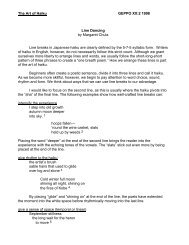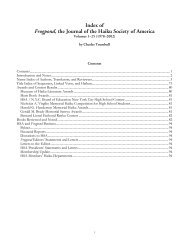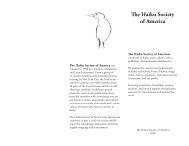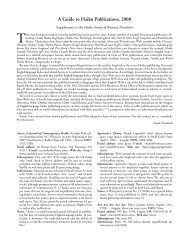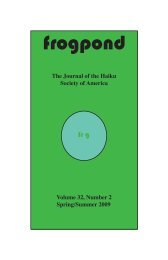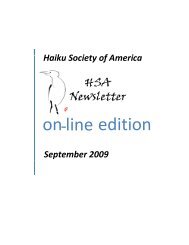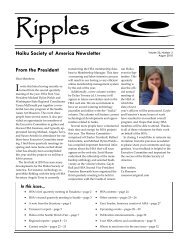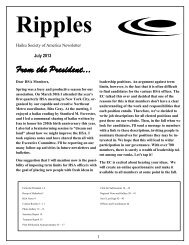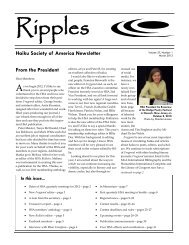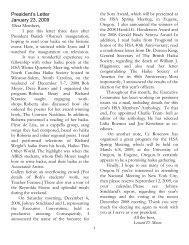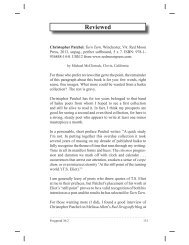Frogpond 34.3 • Autumn 2011 (pdf) - Haiku Society of America
Frogpond 34.3 • Autumn 2011 (pdf) - Haiku Society of America
Frogpond 34.3 • Autumn 2011 (pdf) - Haiku Society of America
You also want an ePaper? Increase the reach of your titles
YUMPU automatically turns print PDFs into web optimized ePapers that Google loves.
Richard Zimler. Love’s Voice, 72 Kabbalistic <strong>Haiku</strong>. New<br />
York: Tarcher Cornerstone Editions, <strong>2011</strong>, 88 pp., perfectbound,<br />
8.5 x 5.5. ISBN 978-1-58542-893-9, $10.<br />
by Bruce Ross, Bangor, Maine<br />
A Master <strong>of</strong> the Universe as Haijin<br />
On the front cover <strong>of</strong> the early paperback edition <strong>of</strong> Zohar,<br />
the primary text <strong>of</strong> Judaic Kabbalah, edited by Gershom Scholem,<br />
the scholar who reintroduced Kabbalah to the modern<br />
world, is a woodcut by Hans Burgkmair (1473-1531) <strong>of</strong> an old<br />
bearded man in a meditative state. He is holding a scaffold.<br />
Superimposed on the scaffold by the cover designer are ten<br />
brightly covered circles. These are the sefira, the codified<br />
symbols <strong>of</strong> God’s attributes. I once met a group who used<br />
these emanations as guides to balance their internal states.<br />
The author <strong>of</strong> this collection is best known for his historical<br />
fiction, <strong>of</strong>ten with a focus on some mystery to be solved, most<br />
notably The Last Kabbalist <strong>of</strong> Lisbon. In his short introduction<br />
Zimler traces his connection to Kabbalah from finding<br />
a copy <strong>of</strong> Scholem’s Major Trends in Jewish Mysticism on<br />
his mother’s bookshelf. He goes on to acknowledge the influence<br />
<strong>of</strong> a number <strong>of</strong> familiar names in modern Kabbalah<br />
scholarship. He includes a short glossary <strong>of</strong> terms used in this<br />
collection.<br />
Why haiku and Kabbalah? Zimler explains: “In large part because<br />
the idea <strong>of</strong> bringing together two such disparate traditions<br />
seemed an exciting challenge, and one that would force<br />
me to find poetic ways <strong>of</strong> expressing mystical ideas.” He then<br />
discusses the haiku form which “<strong>of</strong>ten depends on astonishment<br />
and insight for its charm and beauty.” Does he do what<br />
he says? Yes and no. First, all <strong>of</strong> his three line “poems” are<br />
in the 5-7-5 format. Secondly, he is using this “form,” really<br />
statements, to express <strong>of</strong>ten amusing comments on the ways<br />
and means <strong>of</strong> Kabbalah, not unlike the understanding <strong>of</strong> haiku<br />
as wise sayings by the first haiku translators in the West.<br />
. . . . . . . . . . . . . . . . . . . . . . . . . . . . . . . . . . . . . . . . . . . . . . . . . . . . . . . . . . . .<br />
<strong>Frogpond</strong> 34:3 93



